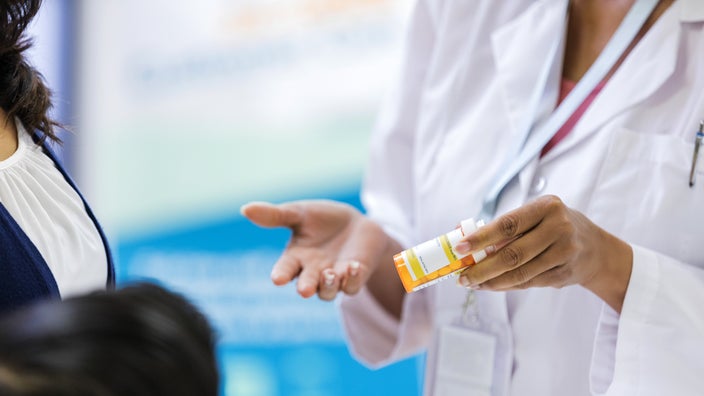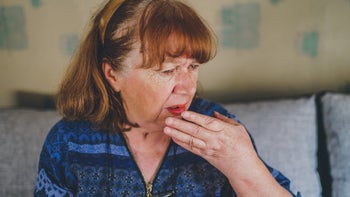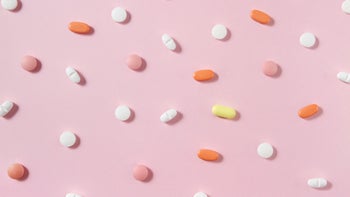
Lithium Dosages: Your GoodRx Guide
Key takeaways:
Lithium (Lithobid) is a mood stabilizer medication that’s approved to treat bipolar disorder in adults and children ages 7 and up. The recommended lithium dosage for adults ranges from 600 mg to 1,800 mg daily. But you’ll likely start with a lower lithium dosage and raise it over time.
You’ll probably need frequent blood testing while taking lithium. These tests help your healthcare provider find the best lithium dose for your symptoms while lowering the risk for harmful side effects.
All forms of immediate- and extended-release lithium are both available as lower-cost generics. GoodRx can help you save over 70% off the average retail price at certain pharmacies.
Access savings on related medications
Table of contents

Lithium (Lithobid) is a mood stabilizer that treats bipolar disorder. It’s a medication with a narrow therapeutic index. This means that even small changes in the amount of lithium in your body can have a large impact. And finding the right lithium dosage to keep your levels within the target window can be tricky.
Below, we’ll take a look at the recommended lithium dosages for adults and children. We’ll also review the steps your healthcare provider will likely take to make sure your lithium levels are where they should be. Keep in mind that your provider may prescribe a different lithium dose for you than described here. It’s best to follow the lithium dosage your provider recommends.
What dosage forms does lithium come in?
Lithium is available as immediate-release tablets and capsules, an oral solution, and extended-release (ER) tablets. Lithium comes in two different forms, known as lithium salts. The tablets and capsules contain lithium carbonate, while the oral solution contains lithium citrate. Both lithium salts work the same way, but if you switch from one to the other you may need an adjustment to your dose.
Each lithium dosage form comes in different doses. Lithium oral solution might stand out since it’s dosed differently, by using milliequivalents (mEq) instead of milligrams (mg). This is just another unit of measurement that’s used for certain medications. It’s also used when measuring the amount of lithium in your blood. Each available dose is detailed in the table below.
Dosage form | Available doses |
Immediate-release tablet | • 300 mg |
Immediate-release capsule | • 150 mg • 300 mg • 600 mg |
Oral solution | • 8 mEq/5 mL (equal to 300 mg/5mL) |
Extended-release tablet | • 300 mg • 450 mg |
Lithium ER tablets should be swallowed whole. You shouldn’t chew or crush them. The oral solution may be a better option for people who have trouble swallowing pills.
What’s the typical lithium dosage for adults?
The lithium dosage in adults depends on why you’re taking it. Lithium can treat acute episodes of mania associated with bipolar I disorder. It can also help keep mood levels stable to prevent manic episodes from happening. This is called maintenance treatment.
Acute mania associated with bipolar I disorder
The typical lithium dosage for adults to treat acute mania is 600 mg 2 to 3 times a day (1,200 mg to 1,800 mg daily). Your healthcare provider may start you at a lower lithium dosage and raise your dose over time. It’s recommended to start with 300 mg 3 times a day and raise it by an additional 300 mg every 3 days until you reach your target dose.
For the ER tablets, the recommended lithium dosage for acute mania is 900 mg twice daily or 600 mg 3 times a day (1,800 mg daily).
Your healthcare provider will likely do frequent blood tests to check your lithium levels. The goal lithium level for acute mania treatment ranges between 0.8 mEq/L to 1.5 mEq/L.
Maintenance treatment of mania associated with bipolar I disorder
The approved lithium dosage for bipolar I disorder maintenance treatment is 300 mg to 600 mg 2 to 3 times a day (600 mg to 1,800 mg daily). You’ll likely start with 300 mg 3 times a day and your healthcare provider will slowly raise your dose from there.
For the ER tablets, the recommended lithium dosage is 900 mg to 1,200 mg per day, divided into 2 or 3 smaller daily doses.
The goal of maintenance treatment is a lithium level between 0.6 mEq/L and 1.2 mEq/L.
What’s the typical lithium dosage for children?
Lithium is also approved for children and adolescents ages 7 years and older. But this only applies to the immediate-release dosage forms, including the oral solution. The ER tablets aren’t approved for children younger than 12 and don’t have specific dosing recommendations for children.
The approved lithium dosages are for children who weigh between 20 kg (44 lbs) to 30 kg (66 lbs). Children weighing over 30 kg (66 lbs) should follow the recommended lithium dosages for adults.
Acute mania associated with bipolar I disorder
The recommended lithium dosage for acute mania in children is 600 mg to 1,500 mg per day. This will be divided into several smaller doses throughout the day. Your healthcare provider may start your child at a lower lithium dosage and slowly increase it over time. It’s recommended to start with 300 mg twice daily, then raise the dose by an additional 300 mg once a week.
The goal lithium level for acute mania treatment in children is 0.8 mEq/L to 1.2 mEq/L.
Maintenance treatment of mania associated with bipolar I disorder
For maintenance treatment of bipolar I disorder, the recommended lithium dosage for children is 600 mg to 1,200 mg per day. This will be divided into several smaller doses throughout the day. It’s likely that your child will start with a lower lithium dosage of 300 mg twice daily. Their dose will be slowly raised over time by their healthcare provider until the recommended dosage is reached.
The goal lithium level for maintenance treatment of mania in children is 0.8 mEq/L to 1 mEq/L.
How is your lithium dose monitored?
Your healthcare provider will use your blood lithium levels to determine your lithium dosage. Be sure to follow your provider’s instructions for a blood draw to be sure they get an accurate level. And do your best not to miss these routine appointments — they’re the best way to make sure you’re getting the treatment you need and limit the risk of harmful side effects.
But keep in mind that these blood levels are just a guide. Your provider will adjust your lithium dosage based on your symptoms and any side effects you’re experiencing as well as your blood lithium levels.
Are there any dosage adjustments for age or medical conditions?
If you have kidney problems, your lithium dosage may be different. Most people with mild or moderate kidney disease can still take lithium. But you may need a lower dosage and more time in between dosage changes. If you have severe kidney disease, lithium isn’t recommended.
If you’re 65 years or older, you may also need a lower lithium dosage. Older individuals can be more sensitive to lithium’s effects and have symptoms of toxicity with typical adult doses.
What happens if you miss a dose of lithium?
If you forget to take a dose of lithium, take it as soon as you remember. But if it’s close to your next dose, skip the missed dose and take only the regular dose. Don’t take two doses at the same time to make up for the one you missed.
If you miss more than one dose of lithium, reach out to your healthcare provider. They’ll be able to help you get back on track with your medication safely. If you’re having trouble remembering to take your lithium, consider a medication reminder app or daily pill organizer to help.
Be sure to let your healthcare provider know if you’ve missed any lithium doses when they’re checking your blood levels. This will help them understand any changes to your lithium levels and avoid unnecessary dosage changes.
What should you do if you take too much lithium?
Taking too much lithium can be a serious issue. Because lithium has a narrow therapeutic index, even a small increase (such as one extra dose) can lead to problematic side effects.
Mild symptoms of lithium toxicity include tremors, feeling lightheaded, and weakness. Moderate symptoms include slurred speech, blurred vision, and confusion. Severe lithium toxicity can cause seizures, coma, and even death.
If you or a loved one takes more lithium than prescribed, contact your healthcare provider right away. You can also call Poison Control at 1-800-222-1222. But if you notice any of the above symptoms, seek emergency medical care as soon as possible.
How to save on lithium
Lithium ER is available as both a brand-name and generic medication. Immediate-release forms of lithium are only available as lower-cost generics.
GoodRx can help you save over 70% off the average retail price of the generic versions of lithium.
Lithium capsules: Pay as little as $4.00 for a 30-day supply
Lithium tablets: Pay as little as $7.39 for a 30-day supply
Lithium oral solution: Pay as little as $32.73 for a 30-day supply
Lithium ER tablets: Pay as little as $9.00 for a 30-day supply
The bottom line
Lithium is a mood stabilizer that’s approved to treat bipolar disorder in adults and children ages 7 and up. The recommended lithium dosage for adults ranges from 600 mg to 1,800 mg daily. This is usually divided into several smaller doses throughout the day.
You’ll likely start with a lower lithium dosage and slowly increase it over time. Your healthcare provider may require frequent blood testing to keep an eye on your lithium levels while this happens. This helps your provider find the best lithium dose for your symptoms while lowering the risk for harmful side effects.
Why trust our experts?



References
AvKARE. (2022). Lithium carbonate ER- lithium carbonate tablet [package insert].
Hedya, S. A., et al. (2023). Lithium toxicity. StatPearls.
Nederlof, M., et al. (2018). Monitoring of patients treated with lithium for bipolar disorder: An international survey. International Journal of Bipolar Disorders.
Remedy Repack Inc. (2023). Lithium carbonate- lithium carbonate capsule, gelatin coated [package insert].
Remedy Repack Inc. (2023). Lithium carbonate- lithium carbonate tablet, extended release [package insert].
Tondo, L., et al. (2019). Clinical use of lithium salts: Guide for users and prescribers. International Journal of Bipolar Disorders.
U.S. Food and Drug Administration. (2017). FY2015 regulatory science research report: Narrow therapeutic index drugs.
Was this page helpful?
Related Articles
Browse medications
View AllResearch prescriptions and over-the-counter medications from A to Z, compare drug prices, and start saving.




















